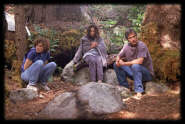 Although I know about John Sayles reputation as a filmmaker, I must admit
that I'd only seen two of his films prior to my receipt of the DVD of
Limbo. I found Brother From Another Planet to be decent but overrated,
but I greatly enjoyed his version of Eight Men Out, a factor that should
have spurred me to watch more of his movies. However, I never did, even
though I knew that Lone Star received a great deal of acclaim. What can I
say? I'm too lazy to seek out those indie films!
Although I know about John Sayles reputation as a filmmaker, I must admit
that I'd only seen two of his films prior to my receipt of the DVD of
Limbo. I found Brother From Another Planet to be decent but overrated,
but I greatly enjoyed his version of Eight Men Out, a factor that should
have spurred me to watch more of his movies. However, I never did, even
though I knew that Lone Star received a great deal of acclaim. What can I
say? I'm too lazy to seek out those indie films!
Anyway, I ended up with Limbo because we received a copy from Columbia
Tristar, and I'm glad I did. While I wasn't bowled over by it, I liked it
well enough to think that maybe I should finally get off my ass and try out
some other Sayles films.
Limbo is billed as a thriller, but I find that description to be
tremendously misleading. (Note: out of necessity, I'm going to reveal some
plot points that you may not want to know if you haven't seen the movie.
For those folks, just skip ahead to the quality reviews.) Yes, some bad
people chase after our main characters and they have to hide from them, but
that's about it; there's no intrigue or cleverness that the characters have
to use to escape. They end up stuck on an island and are completely at the
mercy of the baddies should they find them; no fantastic brainstorm will
occur to turn the tables.
The structure of Limbo is unusual in that half of the film is over before
the "thriller" aspect starts. Prior to that point, the movie comes across
as one of those small character study kind of films; we focus on the
interrelationships of a few folks in a depressed Alaskan town. No, the dire
plot twist isn't completely unexpected; from the minute we see Bobby
Gastineau (Casey Siemaszko), half-brother to main character Joe Gastineau
(David Strathairn), we know he's bad news, and when Bobby involves Joe in
some business, it seems inevitable that something negative will occur.
 While it didn't appear completely predictable that Joe's new romantic
interest Donna (Mary Elizabeth Mastrantonio) and her teen daughter Noelle
(Vanessa Martinez) will also end up embroiled in this nastiness, it wasn't
exactly a surprise. Still, Sayles should be commended for taking his movie
on such an unusual path.
While it didn't appear completely predictable that Joe's new romantic
interest Donna (Mary Elizabeth Mastrantonio) and her teen daughter Noelle
(Vanessa Martinez) will also end up embroiled in this nastiness, it wasn't
exactly a surprise. Still, Sayles should be commended for taking his movie
on such an unusual path.
Despite the problematic predicament that confronts our leads, the movie
doesn't really change thematic course at that point. It was a
character-based film prior to that, and it remains that way through to its
conclusion. The setting and the circumstances change, and the situation
becomes more extreme and allows some vague "thriller" elements, but the
focus stays small and sticks with the personalities. It's a wise decision
because any gratuitous attempts at action or intrigue would have seemed
completely out of place and would have hurt the story.
Limbo possesses an ending that's sure to anger and irritate many. Don't
worry, I won't give away what happens to the characters, but I couldn't do
so even if I wanted to do that. Here's a hint: O. Henry (and I don't mean
the candy bar). It's definitely an unconventional conclusion, but one that
ultimately seems satisfying just because it sticks to the spirit of the
film.
As well as Sayles tells his story, it's the acting that really makes it
work, as is usually the case in such character-intensive films.
Mastrantonio is absolutely excellent as Donna; she incorporates so many
small pieces of emotion and spirit into the character that it was amazing.
Her performance is subtle and captivating; I don't think I've ever seen her
better.
I had mixed feelings about Strathairn's turn as Joe. Don't get me wrong -
he's very good - but I felt he came across as something of a one-trick pony.
What I mean is that I can rarely recall seeing Strathairn play a role in
which he wasn't cast as a pretty basic guy who seems withdrawn and
introverted and has kind of a nervous air about him, like he has something
to hide. Even when he doesn't have something to hide, Strathairn's
characters seem vaguely jittery. That's definitely the case with Joe, and
while it's appropriate for the role, Strathairn's predictability somewhat
detracted from his work.
 I have no history upon which to draw comparisons for Martinez's work as
Noelle, but she seemed terrific. The depressed, bitter teen is not exactly
an original character, but Martinez offers a nice turn on the part. She
manages to make Noelle believable without being overly melodramatic.
I have no history upon which to draw comparisons for Martinez's work as
Noelle, but she seemed terrific. The depressed, bitter teen is not exactly
an original character, but Martinez offers a nice turn on the part. She
manages to make Noelle believable without being overly melodramatic.
Okay, spoiler skippers - you can come back now! Time to discuss the quality
of the DVD. As usual, Columbia Tristar have done an excellent job with this
release. Limbo is presented in its original theatrical aspect ratio of
1.85:1 on this single-sided, single-layered DVD; the image has been enhanced
for widescreen televisions.
Limbo looks absolutely fantastic. Looking for flaws? You won't find them
here. The image seems rock solid and terrifically sharp from start to
finish, with no exceptions in between. I detected not a single print flaw,
nor did I see any digital artifacts or grain. My Panasonic A110 isn't great
at the anamorphic downconversion, but I never detected any problems with the
jagged edges or shimmering qualities that occasionally mar the presentation
of 16X9 enhanced titles on my 4X3 TV.
Colors are fairly subdued in this film, one that sticks to a pretty
monochromatic palette to reflect the natural tones of the Alaskan
wilderness, but hues always seem very solid and accurate. Black levels and
shadow detail are absolutely flawless and rich; check out any of the many
fireside scenes to see how good these can look. I withheld an "A+" rating
from Limbo just because I think that level should be reserved for DVDs
that offer a greater variety of tones and challenges, and Limbo is simply
too basic a movie for that; it lacks the "dazzle" factor that would make it
an "A+." However, it came pretty close - Limbo offers a terrific visual
experience.
The Dolby Digital 5.1 soundtrack of Limbo doesn't approach the heights of
the fantastic picture, but it gets the job done. It's a very front-oriented
mix with very little occurring in the rear channels. We occasionally hear
some gentle ambient effects back there - the best scene displays rainfall
during a storm toward the end of the film - but it's generally pretty slight
and not overly involving. The forward soundstage is good but unspectacular;
again, ambient effects quietly appear in the right and left front speakers,
but since this isn't the kind of film that lends itself to whiz-bang audio,
the focus remains on the dialogue in the center channel.
 What Limbo does best is quality, and all aspects of the audio sound
terrific. Although little of the action uses the speakers, the fine musical
score makes good use of the stereo capabilities of the front channels and it
sounds great; it's a fairly spare track, and it always sound clear and deep
with well-defined instrumentation. Dialogue always seems full and natural
and lacks any indication of being dubbed, even though some of it must have
been due to the shooting locations. As noted, effects are pretty spare -
this ain't Twister - but they seem realistic and accurate. The audio mix
for Limbo nicely complements the film and adds to its effect without
overwhelming the viewer.
What Limbo does best is quality, and all aspects of the audio sound
terrific. Although little of the action uses the speakers, the fine musical
score makes good use of the stereo capabilities of the front channels and it
sounds great; it's a fairly spare track, and it always sound clear and deep
with well-defined instrumentation. Dialogue always seems full and natural
and lacks any indication of being dubbed, even though some of it must have
been due to the shooting locations. As noted, effects are pretty spare -
this ain't Twister - but they seem realistic and accurate. The audio mix
for Limbo nicely complements the film and adds to its effect without
overwhelming the viewer.
The DVD of Limbo won't be mistaken for a full-fledged special edition, but
it includes a few supplements. Key here is the running audio commentary
from director Sayles. It's a mildly interesting but fairly mediocre entry.
Sayles offers some useful tidbits about the characters and motivations, but
for the most part, he sticks to dry technical information. I can't really
fault him for this - it's clear that he doesn't want to overexplain the
movie - but it doesn't make for a great commentary. Still, it was
interesting enough to keep me going all the way to the end, and at least
Sayles talks virtually continuously; the track suffers from almost none of
the gaps that often plague commentaries.
Limbo also includes an isolated music track, which is nice since the score
is good. I was excited to note that the end credits feature a Springsteen
song ("Lift Me Up") that hasn't seen the light of day elsewhere. Actually,
the vocal is nearly unrecognizable as Bruce, since he does it in a falsetto
that I initially mistook for a female voice! I mean, I know Bruce's music
awfully well, so I was quite surprised how hard it was for me to clearly
identify the singer as him. Anyway, the isolated track is there, and it
also includes "highlights" that allow you to easily access some of the more
prominent portions of the score. I thought that last part was a nice touch,
kind of along the same lines as the "cameos" menu in the Austin Powers
DVDs; these are portions of the film that aren't difficult to access through
chapter search, but I thought the additional options help make the process
easier for the viewer.
 Finally, Limbo includes two trailers, one for the film itself and one for
another Sayles work, The Secret of Roan Inish. Despite my feeling that I
should check out more material from Sayles, the latter didn't intrigue me,
but the Limbo trailer is a pretty decent piece of work. Limbo also
offers a four-page booklet inside the case, two of which provide some basic
but interesting details of the creation of the film.
Finally, Limbo includes two trailers, one for the film itself and one for
another Sayles work, The Secret of Roan Inish. Despite my feeling that I
should check out more material from Sayles, the latter didn't intrigue me,
but the Limbo trailer is a pretty decent piece of work. Limbo also
offers a four-page booklet inside the case, two of which provide some basic
but interesting details of the creation of the film.
While I didn't think Limbo was a classic, it's a good deal more thoughtful
and intelligent than most films, and it offers a strong character-based
story without indulging in any of the melodramatic excesses that usually mar
such productions. The DVD from CTS features absolutely stunning visual
quality plus strong audio and a couple of decent supplements. If you
already know that you like this kind of austere filmmaking, Limbo is
definitely a good addition to your collection. If you don't usually tend
toward this type of film, you still may want to give it a try; Limbo is an
affecting and interesting piece of work.

